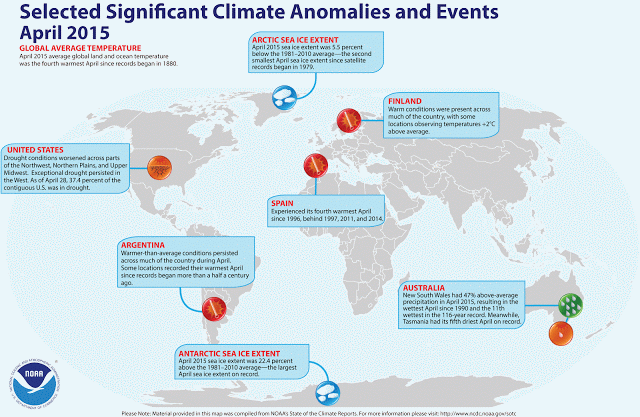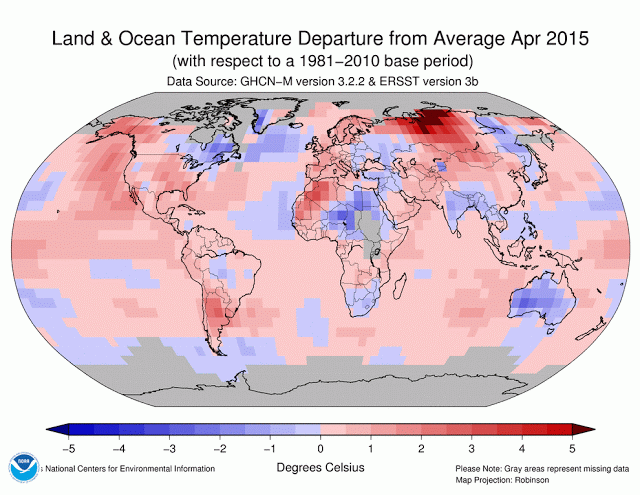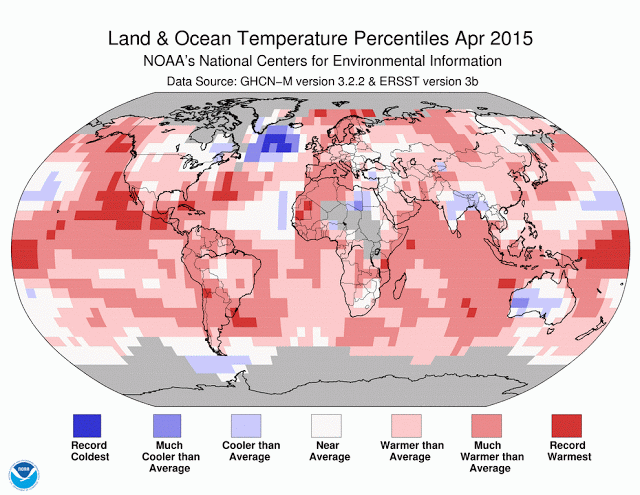The globally averaged temperature over land and ocean surfaces for April 2015 was the fourth highest for the month since record keeping began in 1880. The year-to-date (January–April) globally averaged temperature was record high.
During January–April, the average temperature across global land and ocean surfaces was 1.44°F (0.80°C) above the 20th century average. This was the highest for January–April in the 1880–2015 record, surpassing the previous record of 2010 by 0.13°F (0.07°C).
Temperature anomalies for land and ocean are analyzed separately and then merged to form the global analysis.
Selected Climate Events & Anomalies for April 2015
Temperatures
In the atmosphere, 500-millibar height pressure anomalies correlate well with temperatures at the Earth’s surface. The average position of the upper-level ridges of high pressure and troughs of low pressure—depicted by positive and negative 500-millibar height anomalies on the April 2015 and February–April 2015 maps—is generally reflected by areas of positive and negative temperature anomalies at the surface, respectively.
April
The average temperature across global land and ocean surface temperatures combined for April 2015 was 0.74°C (1.33°F) higher than the 20th century average. This was the fourth highest for April in the 136-year period of record, but also marks the lowest monthly departure from average since November 2014.
Examining the data beyond the traditional calendar year, the latest 12-month period (May 2014–April 2015) ties with the record set last month (April 2014–March 2015) as the warmest 12-month period among all months in the 136-year period of record.
In fact, this record was set several times over the past year, and nine of the ten warmest 12-month periods have occurred within the past two years (September 1997–August 1998 ties as eighth warmest). Nine of these ten 12-month periods also comprise months in two overlapping years. Only the full calendar year of 2014 is among the ten warmest 12-month periods (ties for sixth warmest).
During April, the average temperature across global land and ocean surfaces was 1.33°F (0.74°C) above the 20th century average. This was the fourth highest for April in the 1880–2015 record.
The April globally-averaged land surface temperature was 2.00°F (1.11°C) above the 20th century average. This was the 10th highest for April in the 1880–2015 record.
The April globally-averaged sea surface temperature was 1.08°F (0.60°C) above the 20th century average. This was the highest for April in the 1880–2015 record, surpassing the previous record of 1998 by 0.05°F (0.03°C).
The average Arctic sea ice extent for April was 310,000 square miles (5.5 percent) below the 1981–2010 average. This was the second smallest April extent since records began in 1979, according to analysis by the National Snow and Ice Data Center based on data from NOAA and NASA. This extent was 30,000 square miles larger than the record small April extent that occurred in 2007.
Antarctic sea ice during April was 640,000 square miles (22.4 percent) above the 1981–2010 average. This was the largest April Antarctic sea ice extent on record, surpassing the previous record-large April extent of 2014 by 10,000 square miles.
According to data from NOAA analyzed by the Rutgers Global Snow Lab, the Northern Hemisphere snow cover extent during April was 50,000 square miles below the 1981–2010 average. This was the 22nd smallest April Northern Hemisphere snow cover extent in the 49-year period of record. Eurasia had a slightly larger-than-average April snow cover extent, while North America had its 15th smallest.
Source: NOAA







